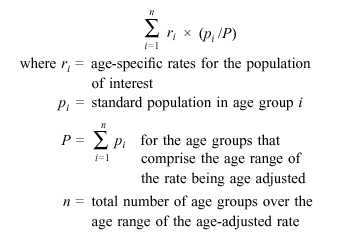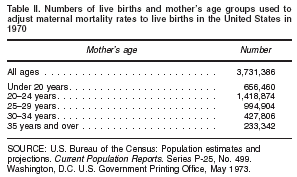
|
|
|
|
|
|
|
|
|
|
|
|
|
|
|
|
|
|
|
|
|
|
|
|
|
|
|
|
|
|
|
|
|
|
|
|
|
|
|
|
|
|
|
|
|
|
|
|
|
|
|
|
|
|
|
|
|
|
|
|
|
|
|
|
|
|
|
|
|
|
|
|
|
|
|
|
|
|
|
|
|
|
|
|
|
|
|
 |
|
|
|

|
|
Age Adjustment
Age adjustment is used to compare risks of two or more populations at one point in time or one population at two or more points in time. Age-adjusted rates should be viewed as relative indexes rather than actual measures of risk. Age-adjusted rates are computed by the direct method by applying age-specific rates in a population of interest to a standardized age distribution, in order to eliminate differences in observed rates that result from age differences in population composition.
Age-adjusted rates are calculated by the direct method as follows:

Age adjustment by the direct method requires use of a standard age distribution. The standard for age adjusting death rates and estimates from surveys in Health, United States is the projected year 2000 U.S. resident population. Starting with Health, United States, 2001, the year 2000 U.S. standard population replaces the 1940 U.S. population for age adjusting mortality statistics. The U.S. standard population also replaces the 1970 civilian non-institutionalized population and 1980 U.S. resident population, which previously had been used as standard age distributions for age adjusting estimates from NCHS surveys.
Changing the standard population has implications for racial and ethnic differentials in mortality. For example, the mortality ratio for the black to white populations is reduced from 1.6 using the 1940 standard to 1.4 using the 2000 standard, reflecting the greater weight that the 2000 standard gives to the older population where race differentials in mortality are smaller.
For
more information on implementation of the new population standard for age
adjustment of death rates, see Age Standardization of
Death Rates: Implementation of the Year 2000 Standard. For
more information on the derivation of age adjustment weights for use with
NCHS survey data, see Age Adjustment Using the 2000
Projected U.S. Population. The United States standard
population is available through the
Mortality
Data
Death rates are age adjusted to the year 2000 standard population
(table I).

Age-adjusted rates are calculated using age-specific death rates per 100,000 population rounded to 1 decimal place. Adjustment is based on 11 age groups with 2 exceptions. First, age-adjusted death rates for black males and black females in 1950 are based on nine age groups, with under 1 year and 1-4 years of age combined as one group, and 75-84 years and 85 years of age and over combined as one group. Second, age-adjusted death rates by educational attainment for the age group 25-64 years are based on four 10-year age groups (25-34 years, 35-44 years, 45-54 years, and 55-64 years).
Age-adjusted rates for years of potential life lost (YPLL) before age 75 years also use the year 2000 standard population and are based on eight age groups (under 1 year, 1-14 years, 15-24 years, and 10-year age groups through 65-74 years).
Maternal mortality rates for pregnancy, childbirth, and the puerperium are calculated as the number of deaths per 100,000 live births. These rates are age adjusted to the 1970 distribution of live births by mother's age in the United States as shown in table II.

National
Health and Nutrition Examination Survey
Estimates based on the National Health Examination Survey (NHES) and the
National Health and Nutrition Examination Survey (NHANES) are age adjusted
to the year 2000 standard population using five age groups: 20-34 years,
35-44 years, 45-54 years, 55-64 years, and 65-74 years (table
III).
Beginning in 1999-2000 estimates are age adjusted using three age groups
(20-39 years, 40-59 years, and 60-74 years or 60 years and over) due to a
smaller sample size; however, use of three rather than five groups had
virtually no effect on age-adjusted estimates (table
III).
National
Health
Care Surveys
Estimates based on the National Hospital Discharge Survey (NHDS), the
National Survey of Ambulatory Surgery (NSAS), the National Ambulatory
Medical Care Survey (NAMCS), the National Hospital Ambulatory Medical Care
Survey (NHAMCS), the National Nursing Home Survey (NNHS) (resident rates
table), and the National Home and Hospice Care Survey (NHHCS) are age
adjusted to the year 2000 standard population (table III).
National
Health Interview Survey
Estimates based on the National Health Interview Survey (NHIS) are age
adjusted to the year 2000 projected resident population (table III).

SOURCE: Health, United States
Related
Links
Age
Standardization of Death Rates: Implementation of the Year 2000
Standard. Vol. 47, No. 3. 20 pp. (PHS) 98-1120
View/download
PDF 260 KB
Healthy People 2010: Age Adjustment Using the 2000
Projected U.S. Population. 10 pp. (PHS) 2001-1237
View/download
PDF 118 KB
Rate, Death and Related Rates
Years of Potential Life Lost
|
A
B
C
D
E
F
G
H
I J K L
M N
O P
Q
R S
T U V
W X
Y Z |
This page last reviewed
June 18, 2004
|

